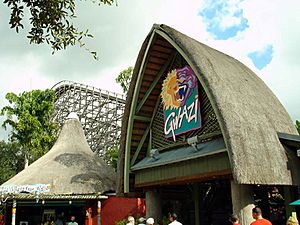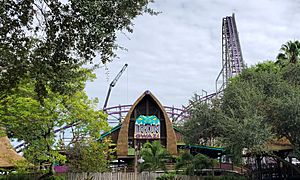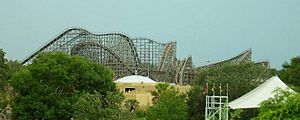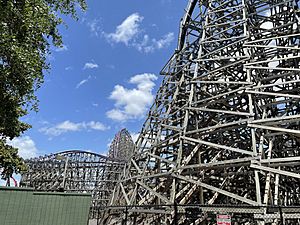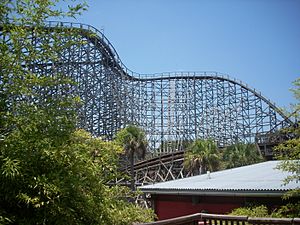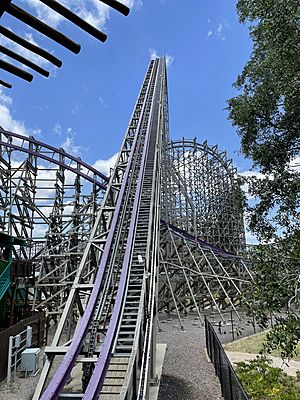Iron Gwazi facts for kids
Quick facts for kids Iron Gwazi |
|
|---|---|
| Previously known as Gwazi (1999–2015) | |
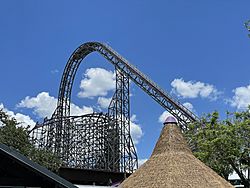
An overview of Iron Gwazi
|
|
| Busch Gardens Tampa Bay | |
| Location | Busch Gardens Tampa Bay |
| Park section | Morocco |
| Coordinates | 28°02′02″N 82°25′23″W / 28.03389°N 82.42306°W |
| Status | Operating |
| Soft opening date | February 13, 2022 |
| Opening date | March 11, 2022 |
| Replaced | Gwazi |
| General statistics | |
| Type | Steel – Hybrid |
| Manufacturer | Rocky Mountain Construction |
| Designer | Alan Schilke |
| Model | I-Box Track |
| Track layout | Twister |
| Lift/launch system | Chain lift hill |
| Height | 206 ft (63 m) |
| Drop | 206 ft (63 m) |
| Length | 4,075 ft (1,242 m) |
| Speed | 76 mph (122 km/h) |
| Inversions | 2 |
| Duration | 1:50 |
| Max vertical angle | 91° |
| Trains | 2 trains with 6 cars. Riders are arranged 2 across in 2 rows for a total of 24 riders per train. |
| Iron Gwazi at RCDB | |
Iron Gwazi is a super exciting hybrid roller coaster at Busch Gardens Tampa Bay theme park in Florida. It's called a "hybrid" because it uses both wood and steel in its structure. This amazing ride was once a completely wooden roller coaster named Gwazi.
Gwazi first opened in 1999. It was a unique "dueling" roller coaster, meaning it had two separate tracks that raced each other! These tracks were named Lion and Tiger, inspired by a mythical creature that was part lion and part tiger. The original Gwazi was 105 feet tall and reached speeds of 51 miles per hour. After many years, it became harder to keep up and wasn't as popular, so it closed in 2015.
But the story didn't end there! In 2019, Busch Gardens announced that Gwazi would get a huge makeover. It was rebuilt with a new steel track by a company called Rocky Mountain Construction (RMC). The new ride, Iron Gwazi, opened in 2022. It's now the tallest, steepest, and fastest hybrid roller coaster in North America! Iron Gwazi stands 206 feet tall and zooms at 76 miles per hour.
Contents
History of the Ride
Building the Original Gwazi
The land where Gwazi was built used to be a brewery. Park planners decided to build a wooden roller coaster to make Busch Gardens different from other Florida parks that used modern steel rides.
A park official named Mark Rose got the idea for the wooden coaster after visiting many other theme parks. He chose a company called Great Coasters International (GCI) to build it. They were known for their awesome wooden roller coasters.
In 1998, Busch Gardens announced their plans for a new $10 million attraction. They even trademarked the name "Gwazi." Construction started in July 1998. The park announced that Gwazi would be a dueling roller coaster, with one side themed to a lion and the other to a tiger.
Gwazi was almost finished by April 1999, and test runs began in May. To celebrate, the park sold "first ride" tickets for a special preview event. Gwazi officially opened on June 18, 1999. It was Florida's first dueling wooden roller coaster!
Over time, Gwazi became known for being a bit rough to ride. The park tried to fix it by replacing parts of the track and even getting new trains in 2011. But it was still hard to maintain, and fewer people wanted to ride it.
In 2012, the Tiger side of Gwazi closed. Then, in December 2014, Busch Gardens announced that the Lion side would also close. After 15 years, Gwazi gave its last rides on February 1, 2015. Parts of the old wooden coaster were even reused in other rides at different parks!
Iron Gwazi's New Life
After Gwazi closed, people wondered what would happen to the space. There were rumors about a new ride or even an amphitheater.
In 2018, Busch Gardens hinted at new construction plans for the Gwazi area. They also filed a trademark for the name "Iron Gwazi." Soon, it was confirmed that Rocky Mountain Construction (RMC) would be transforming the old wooden coaster.
On March 1, 2019, Busch Gardens officially announced Iron Gwazi! It would be a hybrid coaster, using some of the old wooden structure but with a brand new steel track. It was going to be the tallest, steepest, and fastest hybrid coaster in North America.
Construction began, and the new track started to be placed in August 2019. On September 12, 2019, the park revealed the name "Iron Gwazi." They shared its impressive stats: 206 feet tall, a 91-degree drop, and speeds up to 76 miles per hour!
Track work for Iron Gwazi was finished in March 2020, and testing began. However, the COVID-19 pandemic caused delays. The opening was pushed back from 2020 to 2021, and then again to 2022. Finally, on February 13, 2022, Iron Gwazi had a "soft opening" for special passholders. It opened to everyone on March 11, 2022, ready to thrill riders!
Ride Features
The Original Wooden Coaster
The original Gwazi covered a large area of 8 acres. It was built using a lot of wood – over a million board feet of southern yellow pine! It also had two million bolts and 4.4 million nails. The structure was strong enough to handle winds up to 100 miles per hour.
Gwazi originally had trains made by Philadelphia Toboggan Coasters (PTC). Each train had six cars, with two seats in each row, holding 24 riders. Later, in 2011, the park replaced these with newer Millennium Flyer trains from GCI. Both types of trains used a lap bar to keep riders safe.
The two tracks were known as Lion and Tiger. The Lion trains were yellow, and the Tiger trains were blue. The whole area was themed to a struggle between wildcats, with the Lion side looking like a desert and the Tiger side having streams and plants.
The New Steel Coaster
Iron Gwazi now stands where the old Gwazi used to be. It even uses the same station building! The new steel roller coaster was designed and built by Rocky Mountain Construction. About 25% of the original wooden structure was reused, along with 75% of the old foundations. The tall lift hill is now made entirely of steel. The steel track is 4,075 feet long.
Iron Gwazi is themed to a crocodile, just like other animal-themed rides at Busch Gardens. The waiting area teaches you about crocodiles and their conservation.
Iron Gwazi has two trains, each with six cars. Each car has two rows of two seats, so 24 riders can go at once. Riders are held in place by a lap bar. The front of each train looks like a crocodile head, and the trains are painted green, purple, and blue. The track itself is a cool purple color!
What's the Ride Like?
Riding the Original Gwazi
The Lion and Tiger sides of Gwazi followed similar paths as they dueled. Gwazi was famous for its "fly-bys," where the two coasters would pass each other at high speeds, making it feel like they might collide! It was known as the biggest and fastest dueling wooden roller coaster in the Southeast. Each ride lasted about two and a half minutes.
Lion Track
After leaving the station, the train would turn right and dip down to pass the other train. It would then climb the 105-foot lift hill. At the top, it would turn right into a "pre-drop" before plunging down the 91-foot main drop, reaching 51 miles per hour!
The train would then bank right, climb through a left-banked turn, and then drop again. It would go through a right-banked turnaround, then a left turn, and then a series of gentle turns. Next, it would race parallel to the other train, passing the station, and then spiral downward. Finally, after a few more turns, it would hit the brakes and return to the station.
Tiger Track
The Tiger track was very similar. From the station, the train would turn right, then dip into a left U-turn to pass the other train. It would climb the 105-foot lift hill. At the top, it would turn left into a pre-drop, then dive down the 91-foot drop, hitting 51 miles per hour.
The train would then bank right, climb into a right-banked turn, and drop again. It would continue through banked turns, then climb and dip into a left-banked turn. After a series of curves, it would turn into the outer part of the layout with several left turns. Then, it would race parallel to the other train, passing the station, and spiral downward. Finally, after a few more turns, it would hit the brakes and return to the station.
Riding Iron Gwazi
After leaving the station, the train takes a left turn and dips under the waiting line. Then, it takes another left turn to climb the massive 206-foot lift hill. Once at the top, get ready! The train plunges down a thrilling 91-degree drop, reaching its top speed of 76 miles per hour at the bottom.
Next, it climbs another hill and goes into an "over-banked" left turn (where the track banks more than 90 degrees). Then, it drops into another left turn. After that, the train makes a banked right turn that leads into an upside-down "barrel roll" (a slow, twisting inversion).
It then goes into another over-banked left turn, followed by a series of fast, banked turns. The train then passes through a "zero-g stall" (where you feel weightless as you're upside down for a moment). It climbs a small hill, takes a long right turn, and then one final left-banked turn before hitting the brake run. The whole ride takes about two minutes!
How They Compare
| Statistics | Gwazi | Iron Gwazi | |
|---|---|---|---|
| Years | 1999–2012 (Tiger) 1999–2015 (Lion) |
2022–present | |
| Manufacturer | Great Coasters International | Rocky Mountain Construction | |
| Designer | Mike Boodley | Alan Schilke | |
| Track | Wood | Steel | |
| Height | 105.4 ft (32.1 m) | 206 ft (63 m) | |
| Drop | 91.8 ft (28.0 m) | 206 ft (63 m) | |
| Length | 3,508 ft (1,069 m) | 4,075 ft (1,242 m) | |
| Speed | 51 mph (82 km/h) | 76 mph (122 km/h) | |
| Duration | 2:30 | 1:50 | |
| Inversions | 0 | 2 | |
| Max vertical angle | — | 91.0° | |
| Trains | PTC (1999–2011) | GCI (2011–2015) | Rocky Mountain Construction |
See also
- List of attractions at Busch Gardens Tampa Bay
- Steel Vengeance, a similar steel-hybrid roller coaster
- Zadra (roller coaster), a similar steel-hybrid roller coaster


